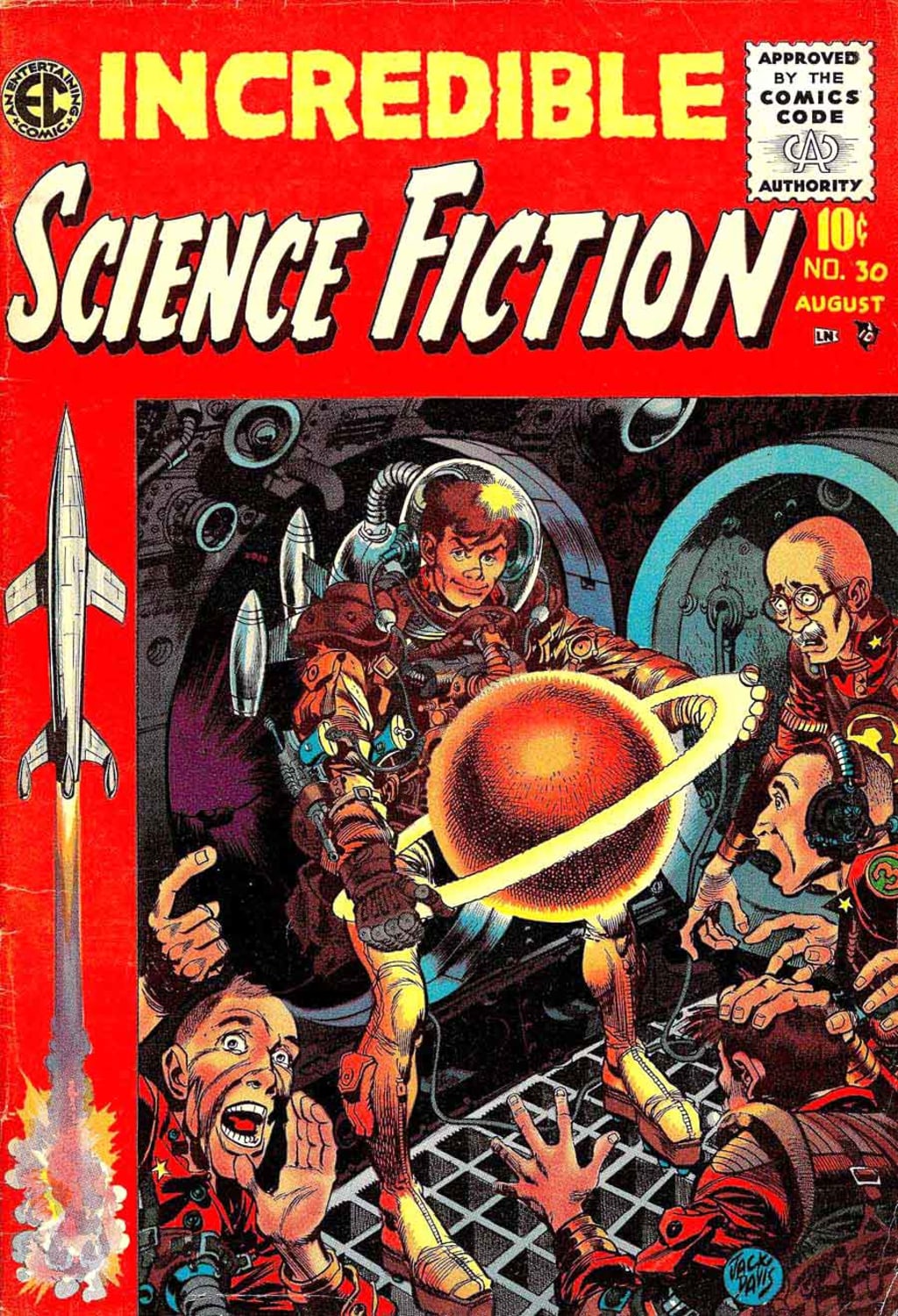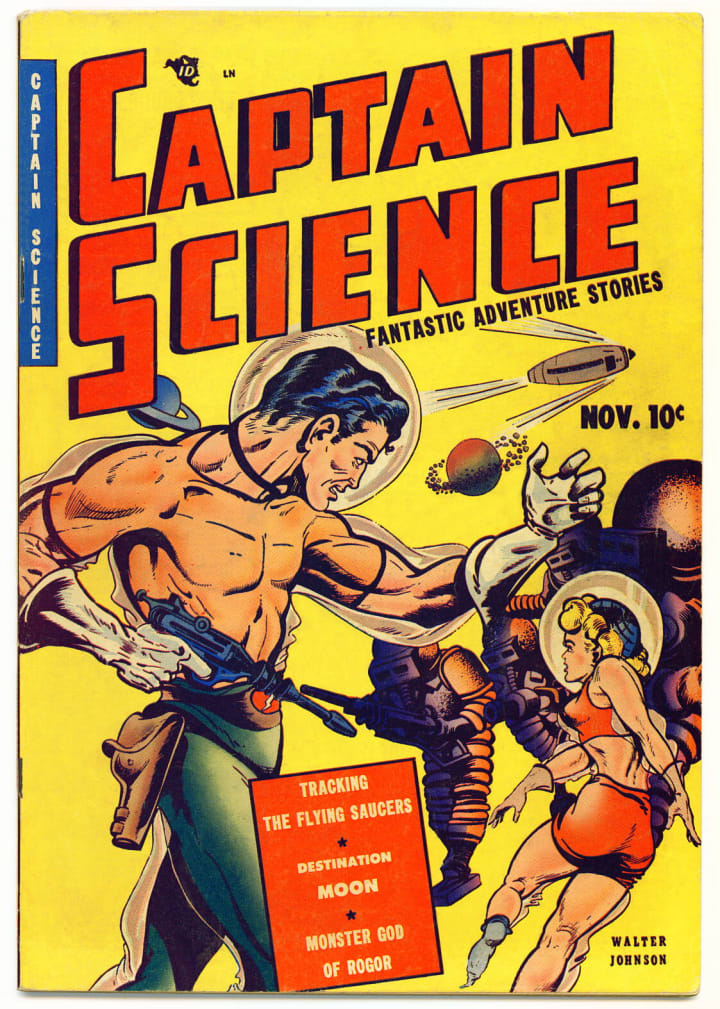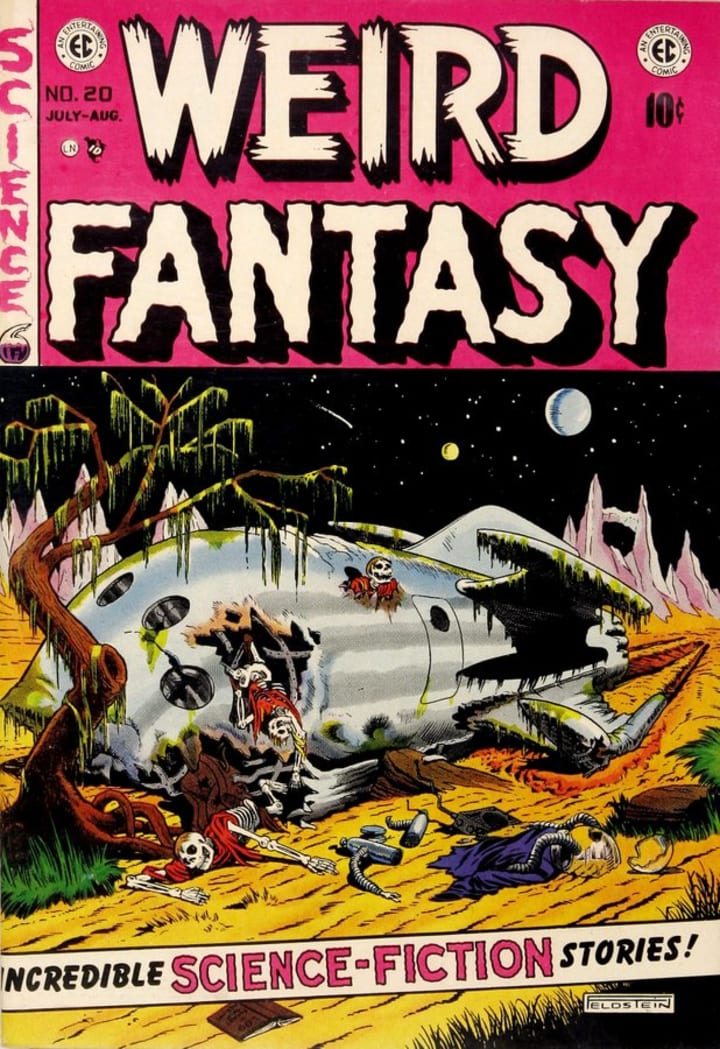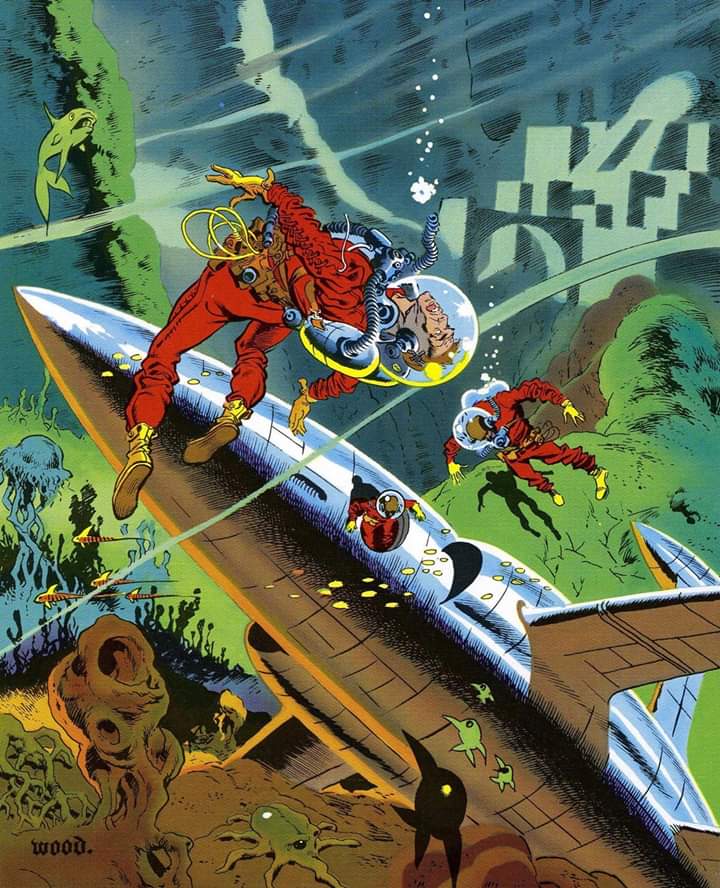The 1950s Science Fiction Podcast: S1E3
Science Fiction Comic Books from the 1950s

Start of Transcript:
Introduction:
Hello, and welcome once again to the 1950s Science Fiction podcast. I hope that you have been enjoying the material I have been presenting so far. Please feel free to send any feedback via the message button on the profile where ever you listen to the podcast. You can also follow me on Twitter and leave me a DM.
In today's episode, I will be discussing the comic books of the 1950s. A subject I have more recently came across via the internet and by reprints of vintage comic titles. I also have a small library of comics from the 50s downloaded to my laptop. They are titles I never heard of until I saw them on the web. Perhaps, the most well know is EC comics, which I will talk about in more detail during the podcast. The 50s had all kinds of comic book adventures through the decade with most of the material aimed at juvenile audiences. Science Fiction did find its way during the decade with such titles as Space Adventures, Captian Science, and Other Worlds. There are even more comics with similar titles competing with one another as well.

I haven't read very many 50s sci-fi comics until more recently, so I am just becoming more familiar with the media itself. I may have read some 50s comics when I was much younger, but it has been so long I can't remember if I did read them and when. The comics I will discuss issues are from my downloads. Some are pre-code, while others have the comics code authority stamped on the cover.
The Rise of The Comics Code Authority.
The decade of the 50s brought prosperity to American society, along with an increasing population of children, a result of the baby boom that occurred after World War Two. Returning servicemen and women got married and produced children by the millions after the war was over. The resulting increase drove the demand for my entertainment for juvenile audiences, and comic book sales increased. However, with the rise of the population, other problems soon followed. Juvenile delinquency increased dramatically, as well.

The rising crime rate by juveniles became so alarming to American society that the US Congress conducted a hearing in the matter. The US Senate convened a subcommittee to investigate the rising delinquent rate and to examine causes during 1953. The following year the committee investigated the comics industry due to allegations made by experts that comics created a bad influence on children. One such expert was a German-American psychiatrist Fredric Wertham who wrote a non-fiction book titled Seduction of the Innocent. In his book, Wertham claimed that comics were a negative influence on the children of America. He cited examples of adult-oriented content within the comic stories themselves, such as drug use, extreme violence, and sexual content. His book was a minor bestseller and aided in the outrage against comics. However, this didn't stop the comics industry from publishing comics. The result of the Congressional hearings was the formation of the Comics Code Authority or CCA. CCA was a board of censors that was self-imposed by the comics industry and was not required by law to do so but by voluntary complacence. The code was similar to the Hayes code used by the Motion Picture industry during the 1930s and onward. The code had strict rules as to what was allowed in comics: No vulgar language, no nudity or sexual situations, and no explicit violence or mutilation. The writer had to be careful in its depictions of authority figures as well.

Pre-code Science Fiction comics.
Now I want to talk about some 50s sci-fi comics there were pre-code. I don't think that sci-fi comics were affected by the scandal that much. It was mostly horror and crime comics that had the most complaints against the industry. However, sci-fi comics still slipped in some adult-oriented themes; I believe I have seen some adult themes in a few of the pre-code comics that I have. For example, in the sci-fi comics Strange Worlds, the cover art does show a scantly clad woman attempting to get into a spaceship while being chased by a gruesome alien being. Also, the first story features a scantly clad dancing girl as well. The first story in the comic is the continuing adventures of Keyton of the Star Patrol. The installment is titled The Corars from the Coalsack. The series is about the exploits of a Buck Rodgers type of character who runs out and saves the universe along with scantily-clad women during the far future. The introduction reads as follows.

"The Atomic bombs that fell on Hiroshima and Nagasaki in 1945 were the opening thunders of the atomic era, culminating in the 1962 rocket landing on the moon. In 1977, a man set for on Mars. A century later on Alpha Centauri, the nearest star. By 3750, many star clusters had been explored, their planetary systems joined with Earth Federation. To police this vast area of billions of miles of empty space-to guard the treasure-laden cargo spacers. The Star Patrol was born. "
The series ran from 1950 to 1952 and published by Avon comics. It was acquired by Alas comics, a forerunner to Marvel, during 1952. The comic was an anthology series that showcased the artwork of Wally Wood. Wood has since become famous in comic book circles as one of the best artists of the era. Keaton of the Star Patrol was an ongoing series during the comics publication.

The comic, published during the pre-code years, was determined by me, was not too explicit by current standers. It did show adults drinking and smoking in some panels but, I think it was the scantly clad females that got people talking.

Other pre-code sci-fi comics were less offensive. One comic, called Captin Science, appears to be more wholesome. I have read a few issues and found it to be acceptable for young readers. The series is about a father and son who, after meeting with an alien being, become defenders of the Earth. They engage in battle with aliens and use the hi-tech the alien left them to use before he died. The series had seven issues published: staring in November of 1950 and the last one printed the following year. The comic artist Wally Wood was one of three artists in the production of the comic for Youthful Magazines

EC Comics: Incredible Science Fiction and Weird Fantasy.
The 50s sci-fi comics I want to talk about here are the EC comics series Incredible Science Fiction and Weird Fantasy. EC Comics stood for Entertainment Comics and founded by Maxwell Gaines and later run by his son William. The comic book publisher specialized in many different genes, which included Science Fiction. The company produced comics with mature themes after William Gains took over for his deceased father. The company started publication during World War Two and ceased in 1956. Unlike his father, William decided to incorporate social and political messages in the comic stories. There subjects the comics tackled were civil rights and equity, anti-war and disarmament, and the environment.

I have in my online comic library two volumes of The EC Archives published by Dark Horse comics. The set contains stories published between 1950 to 1956, during the pre-code years and just after the creation of the CCA. The stories are great, and the artwork is fantastic for its time as well. I have read almost of the first volume and read most of the second one. I love reading the stories: There is everything from space travel, aliens, time travel, and the visions of the future. The series has just about anything a sci-fi fan would want.
I do have a few favorite stories in the series, and I will discuss them now. The first one is called Spawn of Mars. This story is about an expedition to the planet Mars some time in the future. Among the four astronauts is one female, who got selected after dozens of other applicants. One thing about the female space explorer is she is there to do a series of scientific work, not there to cook, clean, and look pretty. As the expedition progresses, she has a funny feeling that the crew was under observation by something; A couple of the male crew members investigate, and only one returns. The crewmember who is missing the latter turns up, and the female explorer is relieved. She had already started a romance with the fellow crewmember. When they get back to Earth, he asks her to marry him, and they get settled as a new couple. The couple also becomes affluent after the return home because she is the first woman on Mars. They share an expensive home, and he the latest sports car. However, tragedy strikes when the car runs off the road, and the husband gets killed. As he lays there dying, she sees that he is realy an alien monster. Then the car explodes, leaving no trace of the alien monster. She wakes up in a hospital, and the nurse tells her that her husband is dead. Just when you think things go worse, well, it gets even worse. The nurse also tells the wife that she is pregnant. Oh Boy!
The story, Spawn of Mars, was written by Al Finstine and William Gains with Wally Wood as the artist. It first appeared in Wried Fantasy #9 in September-October 1951. The artwork in this story was excellent. In keeping with the progressive stance of the comic, they created a female heroine who negated the stereotypes of the period.

Another favorite story is called The Inferiors. This story is another space expiration adventure set in the far future. A crew of a rocketship is continuing to explore distant planets for signs of life. They orbit around a world that shows the remnants of a past civilization. The land on the surface and examine the ruins of a city. A crewman finds a statue of one of the inhabits, and a recording device is discovered inside of it. The device is taken back to the ship for examination. One of the scientists aboard can decode the alien language in the recording and learns a copious amount of information about the inhabitants. He finds that the aliens who dominated the planet centuries ago destroyed themselves in a war with other worlds. The planet inhabited by a race of reptilians creatures was desperate to find a way to preserve their species. They find a means by devolving into a different life form. That life form was a Human being. Once again, another shock ending the comic was famous for doing.
'The Inferiors', written by Al Feldstein, drawn by Wally Wood and published in Weird Science-Fantasy issue #28, March-April 1955. The story makes use of the Ancient Astronaut theory as a plot device.
The stories often remind me of the sci-fi radio dramas X-Munis-One. The radio series had presented some of Ray Bradbury's short stories at around the same time, EC comics published their version. Short Stories such as Zero Hour, Mars is Heaven, and There Will Come Soft Rains were some of his best know work at the time. As mention before, EC Comics was not without controversy. One famous sci-fi story from Wried Fantasy, issue #18, April 1953, entitled Judgment Day; an astronaut travels to a world run by robots only to discover the robots have a class system among themselves. While turning the planet, the astronaut never takes off his helmet due to the atmosphere. When finished, he sends a report back stating that the world is not ready for contact with the Galactic Federation. Upon doing so, he removes his helmet and reviles the astronaut is Black. This comic created an uproar with the CCA, and they wanted the Black character removed. Grains refused to do so and ran the story uncensored.

Conclusion:
Well, I hope that you have enjoyed this episode of the podcast. I plan on being back as soon as I can with another examination on the 50s sci-fi. If you like what I am doing, please send me feedback. Also, feel free to support me as well. Just follow the links on your podcast player page. Thanks for listening.
End of Transcript:
About the Creator
Edward German
A long-time sci-fi fan who loves the internet. I am also writing on subjects other than sci-fi.
you can follow me on "X" @EdwardGerman3 Listen to my podcast The 1950s Science Fiction Podcast on Spotify for Podcasters.
Enjoyed the story? Support the Creator.
Subscribe for free to receive all their stories in your feed. You could also pledge your support or give them a one-off tip, letting them know you appreciate their work.






Comments
There are no comments for this story
Be the first to respond and start the conversation.